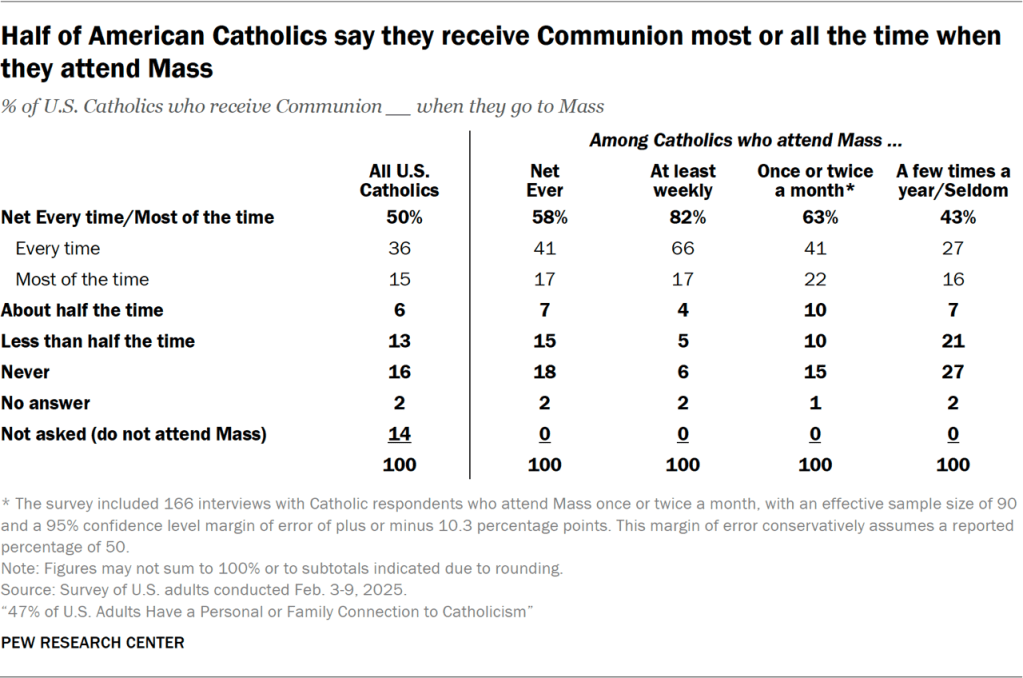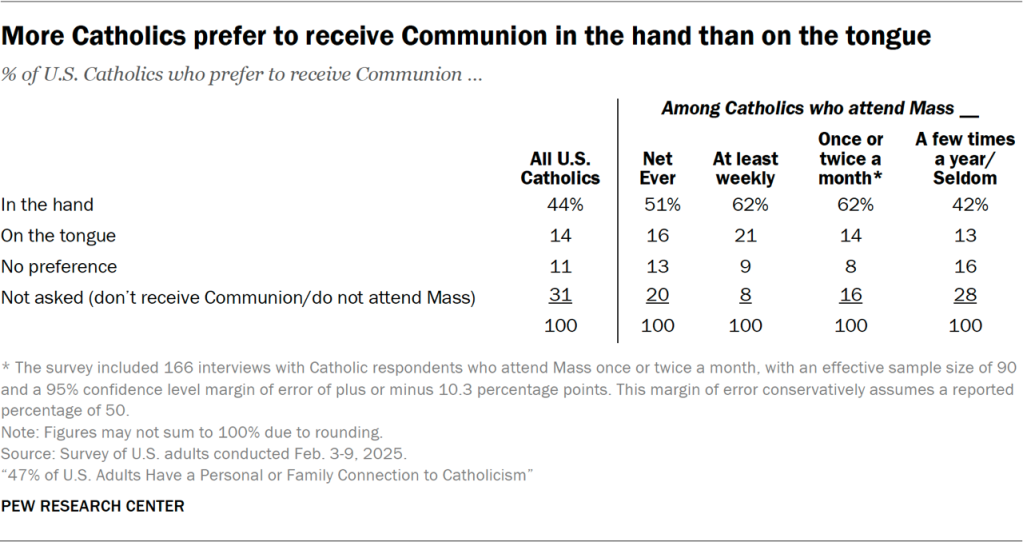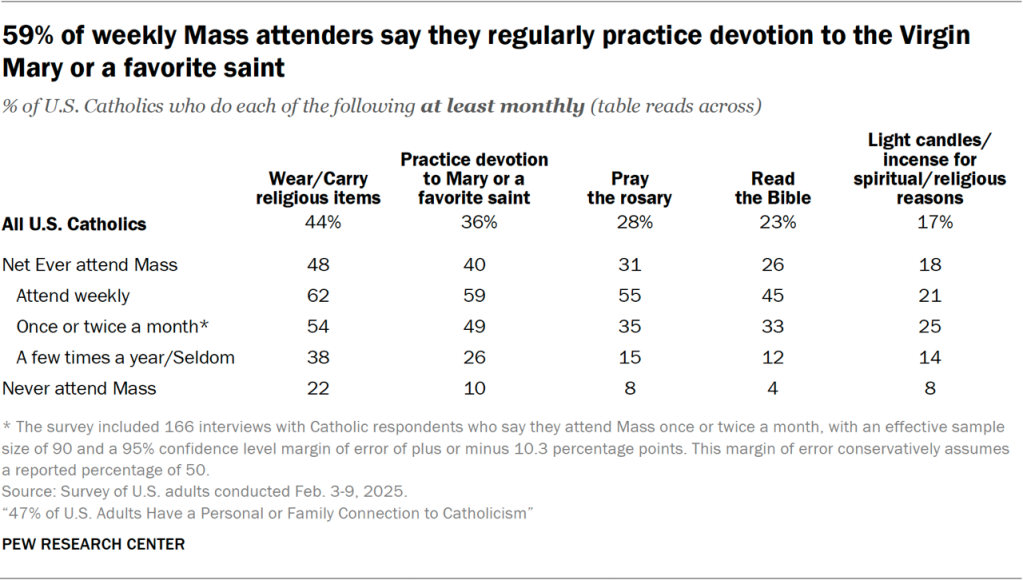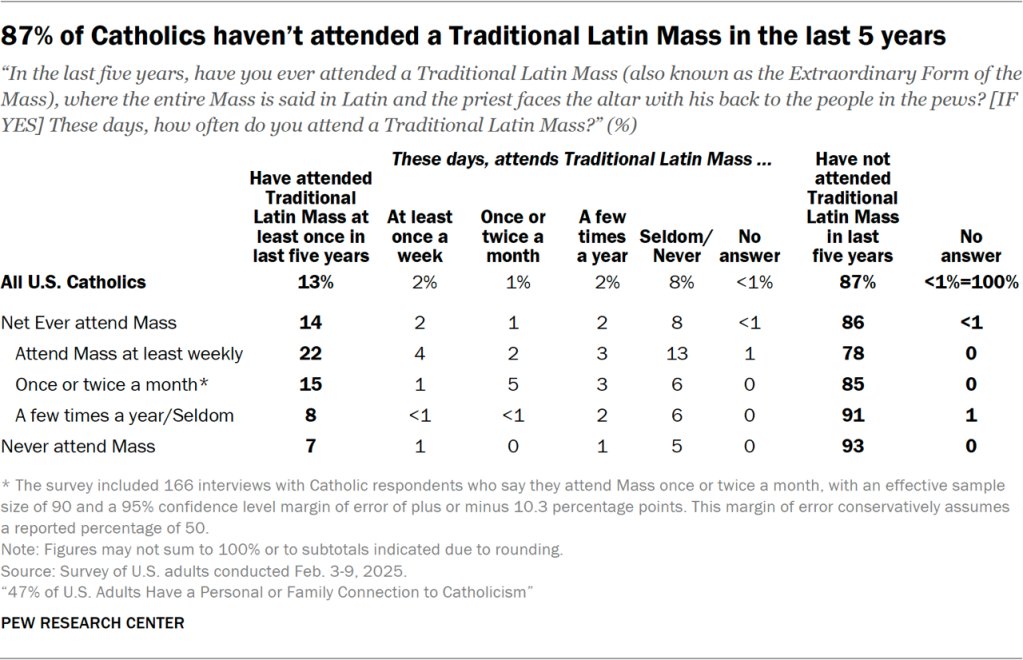There is a wide spectrum of religious observance among U.S. Catholics. Some are quite devout by a variety of traditional measures:
- 50% of U.S. Catholic adults in our 2025 survey say they pray daily.
- 28% say they go to Mass weekly.7
- 23% say they go to confession at least once a year.8

In total, 13% of U.S. Catholics say they engage in all three of these practices. An additional 15% say they do two of them.
Meanwhile, 31% say they do just one of these things. And 40% don’t do any of them – they do not go to Mass each week, do not go to confession at least once a year, and do not pray every day.
Read on for additional information about Catholic practices such as:
- Receiving Communion at Mass
- Confession
- Wearing religious symbols, devotions and other practices
- Traditional Latin Mass
- Anointing of the sick
Going to Mass and receiving Communion
Overall, about three-in-ten U.S. Catholics say they go to religious services at least once a week, according to Pew Research Center’s 2023-24 U.S. Religious Landscape Study (RLS). An additional 11% say they attend Mass once or twice a month.9 And roughly six-in-ten U.S. Catholics say they go to Mass a few times a year or less often (50%) or not at all (9%). (For details on how rates of Mass attendance vary across subgroups based on data from the RLS, refer to the accompanying detailed tables.10)

The Center’s Feb. 3-9, 2025, survey finds that half of U.S. Catholics say they receive Communion every time (36%) or most of the time (15%) they attend Mass. Roughly one-in-five say they receive Communion about half the time (6%) or less than half the time (13%). An additional 16% say they never receive Communion when they go to Mass, and 14% of Catholics in the survey say they never attend Mass in the first place (and thus were not asked how often they receive Communion).

Roughly eight-in-ten weekly Mass attenders receive Communion all or most of the times they go (82%). Lower shares of less frequent attenders say they receive Communion all or most of the time. Still, even among those who go to Mass a few times a year or less often, 43% say they typically receive Communion when they go.
Catholics typically have the option at Mass to receive Communion either in their hand, or placed directly onto their tongue. More Catholics say they prefer to receive Communion in the hand (44%) than on the tongue (14%). An additional 11% say they have no preference. The remainder either don’t receive Communion or don’t attend Mass (and thus were not asked this question).

Confession
Overall, 23% of U.S. Catholics say they go to confession at least once a year, while 30% say they go less often. About half of Catholics (47%) say they never go to confession.
Catholics who go to Mass weekly also tend to go to confession more frequently than those who don’t attend weekly Mass; 53% of weekly attenders say they go to confession at least once a year.

Wearing religious symbols, devotions and other practices
The survey asked Catholics how often they engage in practices such as wearing or carrying religious items; practicing devotions to Mary or a favorite saint; praying the rosary; reading the Bible; and lighting candles or incense for spiritual or religious reasons.
The most common of these practices is wearing or carrying religious items, which 44% of Catholics do monthly. Meanwhile, 36% say they practice devotion to Mary or a favorite saint that often. The least common of these practices is lighting candles or incense for spiritual reasons, which 17% of Catholics say they do monthly.

Weekly Mass attenders are generally more inclined than Catholics overall to engage in these practices. For example, around six-in-ten Catholics who attend Mass at least once a week (62%) say they regularly wear or carry religious items with them, compared with 44% of Catholics overall. Meanwhile, 59% of weekly attenders say they practice devotion to Mary or a favorite saint, compared with 36% of Catholics overall.
The survey also finds that several of these practices are far more common among Hispanic Catholics than White Catholics. For example:
- 56% of Hispanic Catholics say they wear or carry religious items with them at least monthly, compared with 39% of White Catholics.
- 46% of Hispanic Catholics practice devotions to the Virgin Mary or a favorite saint at least monthly, compared with 31% of White Catholics.
- 37% of Hispanic Catholics pray the rosary at least monthly, versus 22% of White Catholics.
- 26% of Hispanic Catholics say they light candles or incense for spiritual or religious reasons at least monthly, compared with 11% among White Catholics.
Refer to Chapter 4 for additional details about the distinctiveness of religious practices among Hispanic Catholics.
Traditional Latin Mass
Overall, 13% of U.S. Catholics (including 22% of those who attend weekly Mass) say they have attended a Traditional Latin Mass (TLM) at least once in the last five years. To help avoid confusion and ensure respondents understood what we meant by “Traditional Latin Mass,” the survey described it as a Mass where “the entire Mass is said in Latin and where the priest faces the altar with his back to the people in the pews.”
People who say they have attended at least one TLM in recent years were then asked how often they attend one “these days.” Very few Catholics report regularly attending a TLM today.11 Overall, 2% of Catholics say they do this at least weekly, 1% do so once or twice a month, and 2% do so a few times a year. An additional 8% say they either seldom or never attend a TLM “these days,” while 87% of U.S. Catholics have not attended one at any point in the last five years.

Anointing of the sick
Most Catholics, including 84% of those who attend Mass at least once a week, say it would be “extremely important” or “very important” to them to receive the sacrament of the anointing of the sick if they were seriously ill.

The importance Catholics attach to this sacrament seems to rise with age. Among Catholics who are ages 65 and older, 64% say it would be extremely or very important to them to receive this element of what is commonly known as last rites, compared with 50% among Catholics ages 18 to 34.




